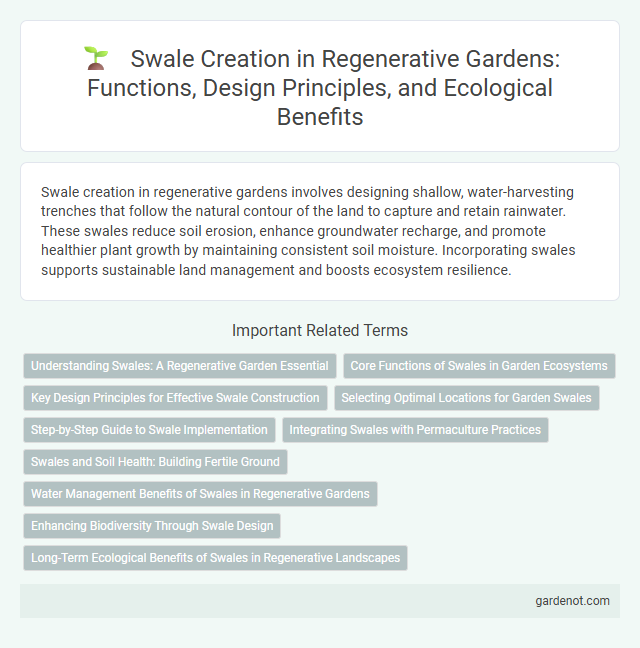Swale creation in regenerative gardens involves designing shallow, water-harvesting trenches that follow the natural contour of the land to capture and retain rainwater. These swales reduce soil erosion, enhance groundwater recharge, and promote healthier plant growth by maintaining consistent soil moisture. Incorporating swales supports sustainable land management and boosts ecosystem resilience.
Understanding Swales: A Regenerative Garden Essential
Swales are shallow, contour-following ditches designed to capture and slow rainwater, promoting infiltration and reducing erosion in regenerative gardens. By directing water into the soil, swales enhance moisture retention, support plant health, and improve microclimates, making them vital for sustainable landscape management. Implementing swales optimizes water use efficiency, sustains soil fertility, and fosters resilient ecosystems in arid and variable rainfall environments.
Core Functions of Swales in Garden Ecosystems
Swales play a crucial role in regenerative garden ecosystems by capturing and directing rainwater, reducing soil erosion, and enhancing groundwater recharge. Their design slows down water flow, enabling infiltration that supports plant hydration and promotes soil microbial health. By pairing swales with native vegetation, gardens improve biodiversity and create resilient microclimates essential for sustainable growth.
Key Design Principles for Effective Swale Construction
Swale creation in regenerative gardening centers on contour alignment to maximize water capture and infiltration, preventing erosion and enhancing soil moisture retention. Incorporating appropriate slope gradients and soil types ensures optimal water flow and nutrient distribution within the swale system. Integrating native vegetation stabilizes swale banks, promotes biodiversity, and improves overall ecosystem health.
Selecting Optimal Locations for Garden Swales
Selecting optimal locations for garden swales involves analyzing slope gradients and soil types to maximize water retention and prevent erosion. Swales are ideally placed along contour lines to capture runoff efficiently, promoting groundwater recharge and supporting plant growth. Strategic placement near tree roots or garden beds enhances moisture availability, improving overall garden health and sustainability.
Step-by-Step Guide to Swale Implementation
Swale creation begins with precise site assessment to identify contour lines for effective water capture and soil retention. Dig trenches along these contours, ensuring proper depth and width to manage runoff while minimizing erosion. Backfill trenches with organic matter and native plants, enhancing soil fertility and stabilizing water flow for regenerative garden sustainability.
Integrating Swales with Permaculture Practices
Swale creation enhances water retention by capturing runoff and directing it into the landscape, promoting soil hydration and reducing erosion. Integrating swales with permaculture practices supports the growth of diverse plant species by creating microclimates and improving nutrient cycling. This synergy fosters resilient ecosystems, increases biodiversity, and sustains long-term garden productivity.
Swales and Soil Health: Building Fertile Ground
Swales play a crucial role in regenerative gardening by capturing and slowly infiltrating rainwater, which reduces erosion and enhances soil moisture retention. The nutrient-rich sediment trapped in swales promotes microbial activity crucial for soil health, fostering fertile ground that supports robust plant growth. Strategic swale placement and design accelerate the restoration of degraded soils, increasing organic matter and improving overall ecosystem resilience.
Water Management Benefits of Swales in Regenerative Gardens
Swale creation in regenerative gardens significantly enhances water management by capturing and slowing runoff, allowing water to infiltrate the soil and reduce erosion. These landscape features promote groundwater recharge and maintain soil moisture, supporting healthy plant growth and increasing drought resilience. Efficient water absorption through swales also minimizes the need for supplemental irrigation, fostering sustainable garden ecosystems.
Enhancing Biodiversity Through Swale Design
Swale creation enhances biodiversity by optimizing water infiltration and providing diverse microhabitats that support native plants and pollinators. Incorporating varied vegetation layers within swales encourages habitat complexity, promoting soil microorganisms, insects, and bird species. Strategic swale placement in regenerative gardens aids in capturing runoff, reducing erosion, and fostering resilient ecosystems that improve overall landscape health.
Long-Term Ecological Benefits of Swales in Regenerative Landscapes
Swales enhance water retention by capturing and slowly infiltrating rainwater, reducing soil erosion and runoff in regenerative gardens. They promote deep groundwater recharge, support diverse plant growth, and improve soil fertility through natural nutrient cycling. Over time, swales contribute to resilient ecosystems by stabilizing microclimates and fostering habitat connectivity.
Swale creation Infographic

 gardenot.com
gardenot.com